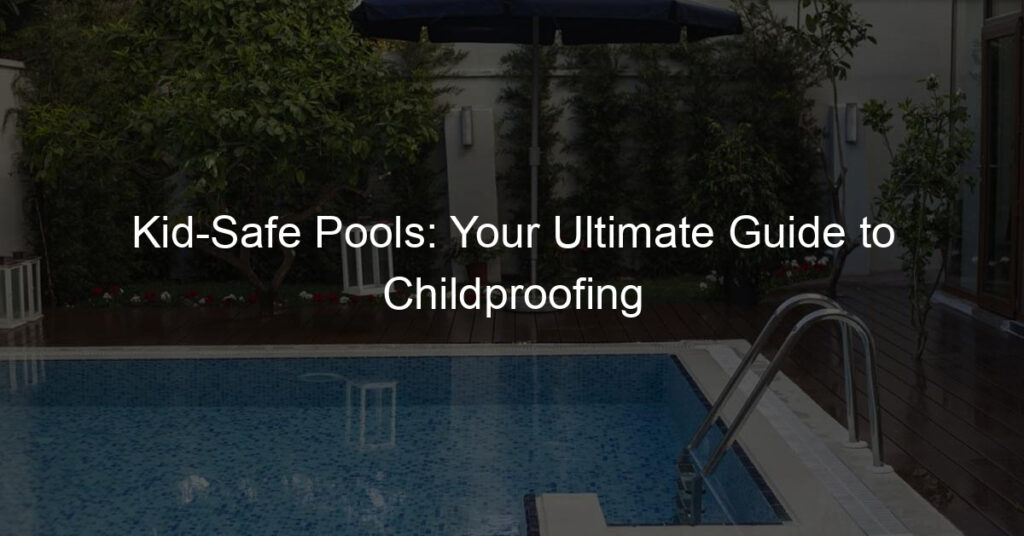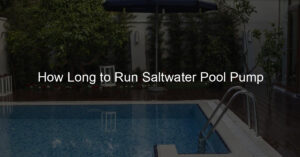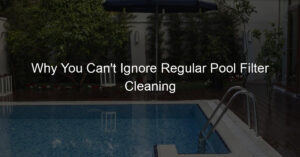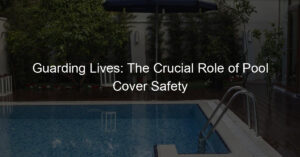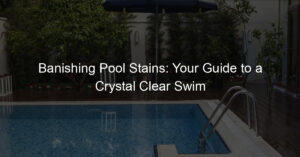Introduction to Childproof Pool Safety
Swimming pools are a great source of fun and relaxation for families, especially during the hot summer months. However, they can also pose significant risks to children if not properly secured. In this post, we will explore the importance of childproof pool safety and understand the risks associated with pool accidents in children.
-
The Importance of Pool Safety for Children
According to the Centers for Disease Control and Prevention, drowning is the leading cause of unintentional death for children aged 1-4 years. This alarming statistic underscores the critical need for pool safety. When a pool is childproofed, it means that measures have been put in place to prevent children from gaining unsupervised access to it. These measures can significantly reduce the risk of accidents and ensure that your pool remains a safe and enjoyable place for your family.
-
Understanding the Risks: Preventing Pool Accidents in Children
Children are naturally curious and often unaware of the dangers that a pool can present. Factors such as lack of swimming ability, unsupervised access, and the absence of pool barriers can contribute to the risk of pool accidents. By understanding these risks, parents and caregivers can take proactive steps to prevent accidents. This can include teaching children to swim at an early age, always supervising them around water, and installing barriers such as pool fences and alarms.
In the following sections, we will delve deeper into the various ways you can childproof your pool, prevent accidents, and ensure a safe and fun pool experience for your children.
Comprehensive Guide to Pool Safety
Ensuring the safety of your swimming pool is a crucial responsibility, especially when children are involved. In this guide, we will focus on three essential steps to childproof your pool: installing pool fences, using pool covers, and setting up pool alarms.
Childproofing Swimming Pools
Childproofing your pool is a multi-step process that involves careful planning and execution. Let’s delve into the specifics:
-
- Installing Pool Fences
Pool fences are a critical safety measure. They serve as a physical barrier that prevents children from accessing the pool area unsupervised. According to the U.S. Consumer Product Safety Commission, a pool fence should be at least 4 feet high and have a self-closing, self-latching gate. This simple measure can significantly reduce the risk of pool-related accidents.
-
- Using Pool Covers
Pool covers are not just for keeping leaves and debris out of your pool. A sturdy, well-fitted pool cover can also prevent children from falling into the water. When choosing a pool cover, ensure it complies with the ASTM F1346 standard for pool safety covers. Remember, a pool cover is not a substitute for adult supervision, but it adds an extra layer of protection.
-
- Pool Alarms: An Extra Layer of Safety
Pool alarms can alert you if someone enters the pool area or falls into the water. They come in various types, including gate alarms, surface wave detectors, and underwater motion alarms. According to a study by the National Safety Council, pool alarms can reduce the risk of drowning by up to 85%. They serve as an extra layer of safety, especially during times when the pool area is not in use.
Remember, these measures are most effective when used together. A fence, a cover, and an alarm each provide different types of protection, and together they create a comprehensive safety system for your pool.
Swimming Pool Safety Measures
Ensuring safety around the swimming pool is of utmost importance, especially when children are involved. Here are some key measures that can significantly reduce the risk of accidents and ensure a safe swimming environment.
-
- Supervision: The First Line of Defense
Adult supervision is the most effective way to prevent accidents. Whether it’s a parent, guardian, or a trained lifeguard, having a responsible adult present can make all the difference. This person should always be alert and focused on the children, avoiding distractions like phone calls or reading. Remember, most child drownings occur within 5 minutes of the child being out of sight.
-
- Teaching Children Water Safety and Swimming Skills
Equipping children with basic water safety knowledge and swimming skills is crucial. This includes teaching them to stay away from pool drains, understanding the importance of swimming with a buddy, and learning how to float or tread water. According to the American Academy of Pediatrics, children as young as 1 year old can benefit from swimming lessons.
-
- Emergency Preparedness: CPR and First Aid
Knowing how to respond in an emergency can save lives. All adults in the home should be trained in CPR (Cardiopulmonary Resuscitation) and basic first aid. This includes understanding how to perform chest compressions and rescue breaths, and how to use an automated external defibrillator (AED). In fact, the American Heart Association states that immediate CPR can double or even triple chances of survival after cardiac arrest.
In conclusion, swimming pool safety is a multifaceted approach that requires vigilance, education, and preparedness. By implementing these measures, we can ensure a safe and enjoyable swimming experience for everyone.
Baby Proofing Your Pool
Ensuring the safety of your children around the pool is of utmost importance. There are several child-safe features you can incorporate into your pool area to make it safer for your little ones. Let’s explore some of these features.
Child-Safe Pool Features
When it comes to baby proofing your pool, certain features can significantly enhance safety. Here are three key features to consider:
-
- Non-Slip Surfaces
Slipping and falling is a common poolside accident among children. To prevent this, consider installing non-slip surfaces around your pool. These surfaces provide extra grip, reducing the risk of falls and injuries. They come in various materials and designs, allowing you to maintain aesthetics while enhancing safety.
-
- Shallow Areas for Young Children
Having a shallow area in your pool is crucial for young children. This allows them to enjoy the water safely under adult supervision. Ensure the shallow end is clearly marked and separate from the deeper parts of the pool. This way, children can play safely without accidentally venturing into deep water.
-
- Pool Lighting for Nighttime Safety
Proper lighting is essential for nighttime pool safety. It allows you and your children to see clearly, preventing accidents. Consider installing underwater lights and lights around the pool area. This not only enhances safety but also adds a beautiful ambiance to your pool area at night.
Remember, while these features can enhance safety, adult supervision is still the best way to prevent pool accidents. Always keep an eye on your children when they are near or in the pool.
Pool Safety Equipment for Children
When it comes to keeping your little ones safe around the pool, there are several pieces of equipment that can provide an extra layer of protection. Here are some of the most effective and commonly used pool safety equipment for children:
-
- Life Jackets and Puddle Jumpers
Life jackets and puddle jumpers are essential safety tools for children. They provide buoyancy that helps keep your child afloat in the water. Life jackets wrap around the chest and back, while puddle jumpers have arm floats attached to a chest piece. These devices are designed to keep the child’s head above water, even if they can’t swim. Remember, these are not a substitute for adult supervision but can provide an extra layer of safety.
-
- Pool Noodles and Floats
Pool noodles and floats are not only fun pool toys but also serve as safety devices. They can help children stay afloat and gain confidence in the water. Pool noodles are long, flexible tubes that children can hold onto or wrap around their bodies. Floats come in various shapes and sizes, from inflatable rings to animal-shaped ride-ons. While they add fun to pool time, they also provide an additional safety measure.
-
- Swim Diapers for Infants and Toddlers
For the smallest swimmers, swim diapers are a must. Unlike regular diapers, swim diapers are designed to contain solid waste without swelling up in the water. This is not only hygienic but also ensures that your infant or toddler can move comfortably in the water. They come in both disposable and reusable versions. Remember, swim diapers should be changed regularly to maintain hygiene.
While these pieces of equipment can enhance safety, they should never replace active supervision. Always keep an eye on your children when they are in or around the pool. With the right equipment and vigilant supervision, you can ensure a safe and enjoyable pool experience for your children.
Preventing Pool Accidents in Children
Swimming pools are a great source of fun for kids, especially during the hot summer months. However, they can also be a source of danger if proper safety measures are not taken. In this section, we will discuss some important rules and regulations that can help prevent pool accidents in children.
Rules and Regulations for Pool Safety
Ensuring pool safety for children involves more than just installing a fence around the pool. It requires a combination of constant supervision, enforcing strict rules, and educating children about the potential dangers. Here are some key strategies to consider:
-
- Establishing and Enforcing Pool Rules
Setting clear and strict rules is the first step towards ensuring pool safety. These rules could include no running around the pool, always swimming with a buddy, and never going into the pool without an adult present. Once these rules are established, they must be consistently enforced to ensure children understand their importance.
-
- Importance of Adult Supervision
Adult supervision is crucial when children are around the pool. An adult should always be present and actively watching when children are in or near the pool. This doesn’t mean just being in the same area, but actually keeping a close eye on the children. According to the Centers for Disease Control and Prevention, drowning is the second leading cause of unintentional injury-related death for children aged 1-14 years, so constant vigilance is key.
-
- Prohibiting Rough Play Near the Pool
Rough play near the pool such as pushing, shoving, or wrestling can lead to accidents. It’s important to make sure children understand that the pool is not a place for roughhousing. This rule should be strictly enforced to prevent any potential accidents.
In conclusion, preventing pool accidents in children involves a combination of establishing and enforcing pool rules, ensuring constant adult supervision, and prohibiting rough play near the pool. By following these guidelines, you can ensure a safe and enjoyable pool experience for your children.
Childproofing Your Home Pool
Ensuring the safety of your children around the home pool is a top priority. It involves more than just teaching them how to swim. It’s about creating a safe environment that minimizes the risk of accidents. Let’s explore some key steps you can take to childproof your home pool.
Regular Maintenance and Safety Checks
Regular maintenance and safety checks are crucial in maintaining a safe swimming environment for your children. These checks involve inspecting various parts of your pool to ensure they are in good condition and functioning as they should. Here are some areas you should focus on:
-
- Checking Pool Fences and Gates
Pool fences and gates are your first line of defense in preventing unsupervised access to the pool area. Ensure they are sturdy, in good condition, and have self-closing and self-latching mechanisms. The latch should be out of reach of small children.
-
- Inspecting Pool Covers and Alarms
Pool covers and alarms add an extra layer of protection. Regularly check your pool cover for any damage and ensure it fits securely over your pool. Pool alarms can alert you if someone enters the pool area or falls into the water. Make sure they are functioning correctly.
-
- Regular Water Quality Testing
Keeping the water in your pool clean and safe is essential. Regularly test the water for correct chlorine and pH levels to prevent harmful bacteria and viruses. This not only keeps your pool safe for swimming but also helps prevent skin and eye irritation.
Remember, childproofing your home pool is an ongoing process. Regular checks and maintenance can help ensure your pool remains a safe and enjoyable place for your children to play and learn to swim.
Conclusion: Ensuring a Safe and Fun Pool Experience for Kids
As we wrap up this comprehensive guide on childproof pool safety, let’s revisit the key points that we’ve discussed. Our goal is to ensure that every child can enjoy a fun, safe pool experience. Remember, it’s not just about the pool itself, but also about the environment around it and the vigilance of those supervising.
-
- Recap of Key Safety Measures
Firstly, we discussed the importance of installing safety barriers around the pool, using pool covers, and ensuring that the pool area is well-lit. We also highlighted the need for non-slip surfaces around the pool to prevent accidents. Additionally, we emphasized the importance of teaching children how to swim and equipping them with life jackets or floaties for added safety.
-
- Importance of Continuous Vigilance
Secondly, we stressed the crucial role of adult supervision in preventing pool accidents. No safety measure can replace the watchful eye of a responsible adult. Regular checks of the pool area for potential hazards, as well as maintaining a clear line of sight to the pool while children are swimming, are key to ensuring safety.
-
- Creating a Safe Pool Environment: A Shared Responsibility
Lastly, we underscored that creating a safe pool environment is a shared responsibility. It involves everyone – from parents and caregivers to pool owners and even the children themselves. Everyone must understand the potential risks and work together to create a safe, enjoyable pool experience.
In conclusion, childproofing your home pool is not a one-time task, but a continuous process that requires vigilance and cooperation from everyone involved. By following these guidelines, we can ensure a safe and fun pool experience for our children.

